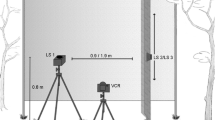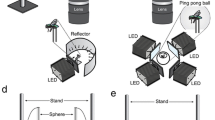Summary
Investigations into the phototactic behavior of the walking blowfly (C.erythrocephala Meig.) led to the following results:
-
1.
The phototactic behavior of female flies under the controlled test conditions is three-phase: (a) a short phase in the first hours after the final moult, in which no one of the two base orientation directions (towards the light or away from it) is preferred, (b) a strongly photopositive phase on the second day, (c) an intensively photonegative phase during the course of the third day of life. This is preserved with a constant strength until at least the tenth day (Figs. 3a, 4a).
-
2.
The phototactic behavior of the male flies is multiphase: the tactic direction changed rhythmically during the total test duration (12 days) with a cycle of about 3 days. The first photopositive phase on the second day after the final moult coincides exactly with that of the females (Figs. 3 b, 4b).
-
3.
At constant test intensity (I t = 300 Lux) the strength of the positive and the negative phototaxis varies, in both sexes, inversely to the illumination intensity (0 Lux≦Ic≦400 Lux) to which the flies had been exposed in their rearing cages for several hours before beginning the test (Figs.4a, b; 5).
-
4.
With constant rearing illumination in the cage (I c = 40 Lux), deviations from the light direction of the courses walked depend on the test intensity in the following complex manner: with stepwise increase in the test intensity from 10−3 Lux to about 101 Lux the standard deviation in the angles walked decreases; from approximately 102 Lux on, it increases. The variance in the walking angles is larger in the case of young flies (2 days) than with older ones (6 or 12 days; Fig. 6).
-
5.
Long-duration measurements at two-hourly test intervals with constant between-test illumination (40 Lux) show no indication of a correlation, under these test conditions, between the strength of phototactic reaction and the daily light-dark cycle (Fig. 7).
Similar content being viewed by others
References
Armbrust, E.J., Gyrisco, G.G.: The influence of some physical and biological factors on the phototactic response of the alfalfa weevil,Hypera postica. Ann. ent. Soc. Amer.61, 1561–1566 (1968)
Barker, R.J., Cohen, C.F.: Factors influencing phototaxis of houseflies. J. Insect Physiol.17, 133–142 (1971)
Batschelet, E.: Statistical methods for an analysis of problems in animal orientation and certain biological rhythms. Amer. I. Biol. Sc. (1965)
Benzer, S.: Behavioral mutants ofDrosophila isolated by countercurrent distribution. Proc. nat. Acad. Sci. (Wash.)58, 1112–1119 (1967)
Berthold jr., R., Benton, A.W.: Honey bee photoresponse as influenced by age. II. Drones and queens. Ann. ent. Soc. Amer.63, 1113–1116 (1970)
Brandt, H.: Lichtorientierung der MehlmotteEphestia. Z. vergl. Physiol.20, 646–673 (1934)
Carpenter, F.W.: The reaction of the pomace fly (Drosophila amph. Loew) to light and gravity and mechanical stimulation. Amer. Naturalist39, 157–171 (1905)
Cassier, P.: Rôle des ocelles frontaux chezLocusta migratoria migratorioides. Insectes Sociaux9, 213–230 (1962)
Cole, W.H.: Note on relation between photic stimulus and the rate of locomotion inDrosophila. Science N.S.55, 678–679 (1922)
Cornwell, P.B.: The functions of the ocelli ofCalliphora (Diptera) andLocusta (Orthoptera). J. exp. Biol.32, 217–237 (1955)
Couturier, A., Robert, P.: Recherches sur les migrations du hanneton commun,Melolontha melolontha L. Ann. Epiphyties3, 257–329 (1958)
Dürrwächter, G.: Untersuchungen über Phototaxis und Geotaxis einiger Drosophila-Mutanten nach Aufzucht in verschiedenen Lichtbedingungen. Z. Tierpsychol.14, 1–28 (1957)
Funktionelle Differenzierung und Wechselwirkungen der Rezeptorsysteme im Komplexauge vonDrosophila melanogaster. Dissertation, Freiburg (1976)
Francia, F.C., Graham, K.: Aspects of orientation behavior in the ambrosia beetle,Trypodendron lineatum (Olivier). Canad. J. Zool.45, 985–1002 (1967)
Gavel, L.v.: Die kritische Streifenbreite als Maß der Sehschärfe beiDrosophila melanogaster. Z. vergl. Physiol.27, 80–135 (1939)
Green, G.W.: The control of spontaneous locomotor activity inPhormia regina Meig. I. Locomotor activity pattern of intact flies. J. Insect Physiol.10, 711–726 (1964)
Hadler, N.M.: Heritability and phototaxis inDrosophila melanogaster. Genetics50, 1269–1277 (1964)
Heisenberg, M.: Comparative behavioral studies on two visual mutants ofDrosophila. J. comp. Physiol.80, 119–136 (1972)
Heisenberg, M., Götz, K.G.: The use of mutants for the partial degeneratiom of vision inDrosophila melanogaster. J. comp. Physiol.98, 217–241 (1975)
Herms, W.B.: The photic reaction of sarcophagic flies, especiallyLucilia caesar L. andCalliphora vomitoria L. J. exp. Zool.10, 167–226 (1911)
Hierholzer, O.: Ein Beitrag zur Frage der Orientierung vonIps curvidens. Z. Tierpsychol.7, 588–620 (1950)
Jander, R.: Grundleistungen der Licht- und Schwereorientierung von Insekten. Z. vergl. Physiol.47, 381–430 (1963)
Jander, R., Barry, C.K.: Die phototaktische Gegenkoppelung von Stirnocellen und Facettenaugen in der Phototropotaxis der Heuschrecken und der Grillen (Saltatoptera:Locusta migratoria undGryllus bimaculatus). Z. vergl. Physiol.57, 432–458 (1968)
Koch, R.: Tagesperiodik der Aktivität und der Orientierung nach Wald und Feld vonDrosophila subobscura undD. obscura. Z. vergl. Physiol.54, 353–394 (1967)
Lewis, T., Taylor, L.R.: Diurnal periodicity of flight by insects. Trans, roy. ent. Soc. Lond.116, 393–476 (1964)
Mast, S.: Photic orientation in insects with special reference to the drone-flyEristalis tenax and the robber-flyErax rufibarbus. J. exp. Zool.38, 109–205 (1923)
McEwen, R.S.: The reaction to light and to gravity inDrosophila and its mutants. J. exp. Zool.25, 49–106 (1918)
Payne, F.:Drosophila amph. Loew bred in the dark for 69 generations. Biol. Bull.21, 297 (1911)
Perttunen, V.: Effect of temperature on light reaction ofBlastophagus piniperda L. (Col., Scolytidae). Ann. Entomol. Fenn.25, 65–71 (1959)
Perttunen, V.: Effect of desiccation on the light reaction of some terrestrial arthropods. Ergebn. Biol.26, 90–97 (1963)
Perttunen, V., Paloheimo, L.: Effect of temperature and light intensity on the light reaction of the larvae and adults ofTenebrio molitor L. (Col., Tenebrionidae). Ann. Entomol. Fenn.29, 171–184 (1963)
Pulliainen, E., Nederström, A.: Studies on the orientation ofChrysomela varians Schall, (Col., Chrysomelidae). II. Light reactions. Ann. Entomol. Fenn.32, 58–68 (1966)
Schümperli, R.F.: Evidence for colour vision inDrosophila melanogaster through spontaneous choice behaviour. J. comp. Physiol.86, 77–94 (1973)
Shepherd, R.F.: Factors influencing the orientation and rates of activity ofDendroctonus ponderosae (Coleoptera: Scolytidae). Canad. Ent.98, 507–518 (1966)
Tsutsumi, C.: Characteristics of the daily behavior and activity patterns of the adult housefly with special reference to time keeping device. Jap. J. med. Sci. Biol.26, 119–141 (1973)
Author information
Authors and Affiliations
Additional information
This work was supported by the DFG-(Me 417/4)
I would like to thank Prof. K. Kirschfeld for supporting this investigation, for many valuable discussions and for reading the manuscript. I also thank Dr. P. McIntyre and Mr. S. Foster for reading the English manuscript.
Rights and permissions
About this article
Cite this article
Meyer, H.W. Phototaxis in the walking male and female fly (Calliphora erythrocephala Meig.). J. Comp. Physiol. 123, 307–314 (1978). https://doi.org/10.1007/BF00656964
Accepted:
Issue Date:
DOI: https://doi.org/10.1007/BF00656964




